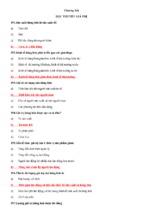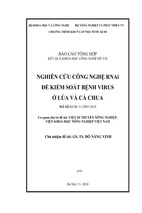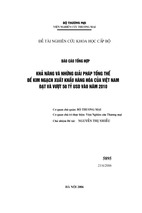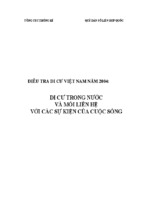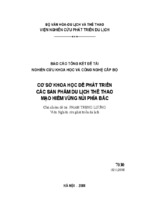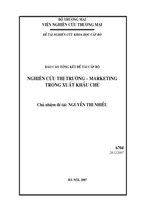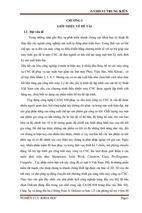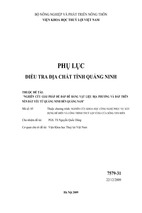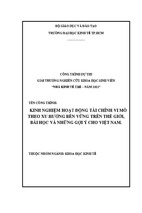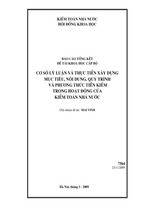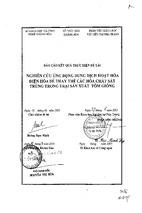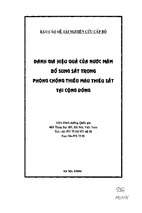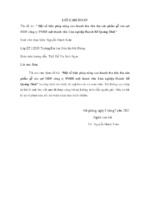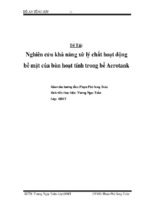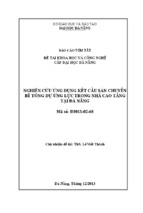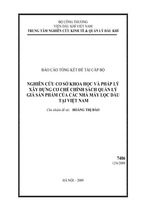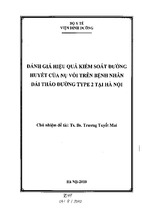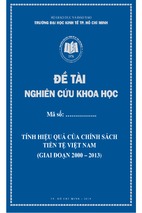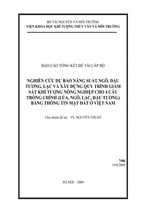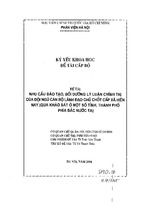VIETNAM NATIONAL UNIVERSITY, HANOI
------------------------------------------------------------------------UNIVERSITY OF LANGUAGES AND INTERNATIONAL STUDIES
NGUYỄN THỊ MINH TÂM
LOGICO-SEMANTIC RELATIONSHIP IN ENGLISH AND
VIETNAMESE CLAUSE COMPLEXES
(SO SÁNH MỐI QUAN HỆ LOGIC-NGỮ NGHĨA TRONG TỔ
HỢP CÚ TIẾNG ANH VÀ TIẾNG VIỆT)
Major: English Linguistics
Code: 62 22 15 01
DOCTORAL DISSERTATION OF ENGLISH
SUPERVISOR: PROF. DR. HOÀNG VĂN VÂN
HANOI -2013
KKeett--nnooii..ccoomm kkhhoo ttaaii lliieeuu mmiieenn pphhii
TABLE OF CONTENTS
INTRODUCTION
Rationale
Aims of the study
Significant of the study
Scope of the study
The research question
The research design, methodology, and data
The organization of the study
1
3
3
3
4
4
5
CHAPTER 1: SYSTEMIC FUNCTIONAL LINGUISTICS AND THE
THEORETICAL FRAMEWORK OF LOGICO-SEMANTIC RELATIONSHIP
IN CLAUSE COMPLEXES
1.1. . Systemic functional theory
1.1.1. Historical context of the emergence of systemic functional theory: a brief
overview
1.1.2. Functional approach – a general description
1.1.3. Systemic functional linguistics
1.1.3.1. Text and context in the view of SFL
1.1.3.2. How ―systemic‖?
1.1.3.3. How ―functional‖?
1.1.4. Review of related studies
1.1.4.1. An overview of studies in Vietnamese grammar
1.1.4.2. SFL studies in other languages
1.1.5. Summary
1.2. The theoretical framework of logico-semantic relationship in clause
complexes
1.2.1. The notion of clause complex in the light of SFL
1.2.1.1. Concepts revisited
1.2.1.2. What is a clause complex?
1.2.1.3. Where is the clause complex located in the overall linguistic
system?
1.2.1.4. How is the clause complex organized?
1.2.2. Analytical frameworks of logico-semantic relations in clause complexes
1.2.2.1. Projection in clause complexes
1.2.2.2. Expansion in clause complexes
4
6
6
6
9
11
12
13
15
20
20
22
22
23
23
23
29
36
38
41
41
50
CHAPTER 2: METHODOLOGY, DATA, AND GENERALFINDINGS
2.1. Research question restated
2.2. Research design
2.3. The methodology
2.4. Methods of the study
2.5. . Data collecting procedure
2.5.1. Corpus compilation
2.5.2. Corpus annotation and data processing
2.5.2.1. The computational tool
2.5.2.2. The process of annotating and processing the data
2.6. . Data analysis
2.6.1. Describing the data
2.6.2. Comparing the two groups of data
2.7.General findings
59
59
59
61
62
62
62
64
64
67
71
71
72
73
CHAPTER 3: FINDINGS AND DISCUSSION: PROJECTION IN ENGLISH
AND VIETNAMESE CLAUSE COMPLEXES
75
3.1. Projection in English Clause Complexes
3.1.1. ow is projection realized in English Clause Complexes
3.1.1.1. Projecting clauses
3.1.1.2. Projected clauses
3.1.1.3. Projecting and projected clauses paratactically related
3.1.1.4. Projecting and projected clauses hypotactically related
3.1.2. ow does Projection work in English clause complexes
3.1.2.1. How does quoting work in English clause complexes
3.1.2.2. How does hypotactic reporting work in English clause
complexes
3.1.2.3. How does paratactic reporting work in English clause complexes
3.1.2.4. How does projection facilitate other linguistic phenomena in
English clause complexes
3.1.3. ummary
3.2. Projection in Vietnamese clause complexes
3.2.1. ow is projection realized in Vietnamese Clause Complexes
3.2.1.1. Projecting clauses
3.2.1.2. Projected clauses
3.2.1.3. Projecting and projected clauses paratactically related
3.2.1.4. Projecting and projected clauses hypotactically related
3.2.2. How does projection work in Vietnamese clause complexes
3.2.2.1. How does quoting work in Vietnamese clause complexes
75
75
75
85
87
88
90
90
91
94
96
100
104
104
104
113
115
117
118
118
KKeett--nnooii..ccoomm kkhhoo ttaaii lliieeuu mmiieenn pphhii
3.2.2.2. How does hypotactic reporting work in English clause complexes
3.2.2.3. How does paratactic reporting work in English clause complexes
3.2.2.4. How does projection facilitate other linguistic phenomena in
English clause complexes
3.2.3. Summary
3.3. . Comparing logico-semantic relation of projection in English and
Vietnamese clause complexes
3.3.1. Realization of projection in English and Vietnamese clause complexes
3.3.1.1. Projecting clauses
3.3.1.2. Projected clauses
3.3.1.3. Projecting and projected clauses paratactically related
3.3.1.4. Projecting and projected clauses hypotactically related
3.3.2. eration of projection in English and Vietnamese clause complexes
3.3.2.1. Operation of quoting in English and Vietnamese clause
complexes
3.3.2.2. Operation of hypotactic reporting in English and Vietnamese
clause complexes
3.3.2.3. Operation of paratactic reporting in English and Vietnamese
clause complexes
3.3.2.4. Projection in relation with other linguistic phenomena in English
and Vietnamese clause complexes
3.4. Summary
CHAPTER 4: FINDINGS AND DISCUSSION: EXPANSION IN ENGLISH AND
VIETNAMESE CLAUSE COMPLEXES
4.1. Expansion in English clause complexes
4.1.1. ow is expansion realized in English clause complexes
4.1.1.1. Expanding clauses
4.1.1.2. Expanded clauses
4.1.1.3. Conjunctions in English clause complexes of expansion
4.1.1.4. Expanding clause and expanded clause paratactically related
4.1.1.5. Expanding clause and expanded clause hypotactically related
4.1.2. ow does expansion work in English clause complexes
4.1.2.1. How does elaboration work in English clause complexes
4.1.2.2. How does extension work in English clause complexes
4.1.2.3. How does enhancement work in English clause complexes
4.1.2.4. How does expansion facilitate ellipsis in the clause complex
4.1.3. ummary
4.2. Expansion in Vietnamese clause complexes
4.2.1. ow is expansion realized in Vietnamese clause complexes
119
122
124
127
130
130
130
132
132
133
133
133
133
134
134
135
136
136
136
136
139
141
143
145
147
147
150
152
155
156
160
160
4.2.1.1. Expanding clauses
4.2.1.2. Expanded clauses
4.2.1.3. Conjunctions in Vietnamese clause complexes of
expansion
4.2.1.4. Expanding clause and expanded clause paratactically
related
4.2.1.5. Expanding clause and expanded clause hypotactically
related
4.2.2. ow does expansion work in English clause complexes
5.1.2.1. How does elaboration work in English clause complexes
5.1.2.2. How does extension work in English clause complexes
5.1.2.3. How does enhancement work in English clause complexes
5.1.2.4. How does expansion facilitate ellipsis in the clause complex
4.2.3. ummary
4.3.Comparing the logico-semantic relation of expansion in English and
Vietnamese clause complexes
4.3.1. Comparing the realization of expansion in English and Vietnamese
clause complexes
4.3.1.1. Expanding clauses
4.3.1.2. Expanded clauses
4.3.1.3. Conjunctions
4.3.1.4. Expanding clause and expanded clause paratactically
related
4.3.1.5. Expanding clause and expanded clause hypotactically
related
4.3.2. Comparing the operation of expansion in English and Vietnamese
clause complexes
4.3.2.1. Elaboration in English and Vietnamese clause complexes
4.3.2.2. Extension in English and Vietnamese clause complexes
4.3.2.3. Enhancement in English and Vietnamese clause
complexes
4.3.2.4. Expansion and ellipsis in English and Vietnamese clause
complexes
CONCLUSION
THESIS-RELATED PUBLICATION
BIBLIOGRAPHY
SOURCES OF DATA
160
162
164
168
170
172
172
175
178
180
181
186
186
186
186
187
188
189
189
189
190
190
191
192
202
203
210
7
KKeett--nnooii..ccoomm kkhhoo ttaaii lliieeuu mmiieenn pphhii
LIST OF FIGURES
Fig.1: ―Systemic‖ means making choice in a network
14
Fig 2: The Stratification
15
Fig. 3: The View of the Grammar so far, Relative to Expansion by Metafunction and
16
Rank
Fig. 4: Metafunctions as manifested in the system network of the clause
19
Fig. 5: Rank-based Constituency (Matthiessen & Halliday
24
Fig. 6: The Rank scale
25
Fig.7. Delicacy in relation to the metafunctions of language and rank
26
Fig.8. Univariate and Multivariate Structure
27
Fig. 9: Three lines of meanings in a clause – 1
29
Fig. 10: Three lines of meanings in a clause – 2
30
Fig. 11: Combining clauses into clause complex
31
Fig. 12: The rank of the clause complex
33
Fig. 13: The Location of Clause Complex in the Overall Linguistic System
38
Fig. 14: Clauses in paratactic and hypotactic clause complexes
39
Fig. 15: The Logico-semantic Relations
40
Fig.16: Positions of Projecting Clauses
42
Fig.17: Speech Functions of Projected Clauses
43
Fig. 18: Clause Moods of Projected Clauses
44
Fig. 19: Quoting vs. Paratactic Reporting
44
Fig. 20: Paratactic vs. Hypotactic Projection
45
Fig. 21: Projecting Processes and Mood of Projected Clause in Combination
46
Fig. 22: Projecting Processes in Quoting and Hypotactic Reporting
47
Fig. 23: The framework of projection in clause complexes
49
Fig. 24: Possible Positions of Expanding Clauses
51
Fig.25: An Analysis of a Clause complex of Expansion
51
Fig. 26: Clause Moods of Expanded Clauses
52
Fig. 27: Expanding and Expanded Clauses Paratactically Related
53
Fig. 28: Meaning of some Verbal Hypotactic Expanding Markers
54
Fig. 29: Modes of Elaborating Relation
55
Fig. 30: Modes of Extending Relation
56
Fig. 31: Modes of Enhancement
56
Fig. 32: The Framework of Expansion in Clause Complexes
58
Fig. 33: Overview of the analysis process in SysFan
66
Fig. 34: Chunking a group into clause complexes
68
Fig. 35: Chunking a clause complex into clauses
69
Fig. 36: Seven possible levels of chunking clause complexes
69
Fig. 37: Labeling the clauses in analysis
70
Fig.38: Distribution maps of clause complex relation types
71
Fig. 39: Complex Combination of Clauses – 1
124
Fig. 40: Complex Combination of Clauses - 2
125
Fig.41: The multi-function expanded clause in English
140
Fig.42: A Multi-function Expanded Clause in Vietnamese
163
9
KKeett--nnooii..ccoomm kkhhoo ttaaii lliieeuu mmiieenn pphhii
LIST OF SYMBOLS
SYMBOLS
MEANING OF SYMBOLS
||
clause divider
|||
complex divider
^
clause conjunction
α , β, Ɣ …
hypotactic related clauses
1, 2, 3,…
paratactic related clauses
‟
Idea
”
Locution
.
Proposition
!
Proposal
+
Extension
=
Elaboration
x
Enhancement
[…]
Embedding
INTRODUCTION
1. Rationale
Over the years, functional approach has had a significant impact on the study of
grammar. This theoretical approach tries to incorporate meaning, function, context, and
grammatical categories. Funtionalism has been developed by many functional grammarians
like Dik (1978), Halliday (1985, 1994), Bloor (1994), Eggins (1994), Thompson (1996),
Lock (1997), Martin (1997), VanValin and LaPolla (1997), Matthiessen (2002), and many
others. Different functional theories have emerged, representing a great range of theoretical
opinion, but the central theme of the functionalist theories is: functional motivation is an
alternative to innateness. Linguistic theories which reject the syntactocentric or formal view
and adopt the communication and cognition perspective include Functional Grammar (Dik,
1978, 1991), Systemic Functional Grammar (Halliday 1994), Role and Reference Grammar
(RRG; VanValin and LaPolla 1997), Lexical Functional Grammar (LFG; Bresnan 2001), etc.
Unlike the linguistic theory that is still the received tradition in school, functionalism takes
the resource perspective rather than the rule perspective; and it is designed to display the
overall system of grammar rather than only fragments. It wishes to be a theory which is
'functional' in at least three different, though interrelated senses:
i.
It takes a functional view on the nature of language;
ii.
It attaches primary importance to functional relations at different levels in the
organization of language;
iii.
It wishes to be practically applicable to the analysis of different aspects of language
and language use.
Functional theories can be described in three groups: extreme, moderate and
conservative, all are common in basically a rejection of the syntactocentric view of formalists
and a recognition of the importance of the communicative factors, cognitive factors or both in
grammatical theory and analysis. Among the three, systemic functional grammar (SFL)
belongs to the moderate group. Systemic functional linguistics (SFL) is an approach to
language developed mainly by M.A.K. Halliday in the UK and later in Australia. This
approach has its origin in the main intellectual tradition of European linguistics that
developed following the work of Saussure. Its primary source was the work of J.R. Firth
(1957) and his colleagues in London, who defines ―system‖ in systemic functional
1
linguistics, as, in its technical sense, the ―theoretical representation of paradigmatic
relations, contrasted
2
KKeett--nnooii..ccoomm kkhhoo ttaaii lliieeuu mmiieenn pphhii
with ―structure‖ for syntagmatic relations‖, and who characterizes systemic theory as
the theory in which the system takes priority, the most abstract representation at any level
is in paradigmatic terms. As well as other schools of thought in Europe such as
glossemantics, this theory also draws on American anthropological linguistics, and on
traditional and modern linguistics as developed in China. While American-style linguistics
evolved in the modeling of the world‘s languages, SFL was developed to address the need
of language teaching and learning. A significant milestone in the development of this
theory is when it was wholly developed in the work on the grammar of Chinese by
Halliday (1956); and it has been used in educational and computational contexts from an
early stage.
With the primary goal of addressing the needs of language teaching / learning,
systemic functional grammar (SFG), the theory of grammar in the light of SFL, lays an
emphasis on the functions of language - what language is used for. Although SFG is a theory
of grammar, it focuses more on the meaning, not the pure form of what is said like what
formalists have long been doing.
Since 1980, SFL has been expanded considerably in various directions; further studies
have been devoted to languages other than English, notably Chinese, French, Indonesian,
Japanese and some other Asian and African languages. It has not been of much popular use in
Vietnam studies of grammar. In Vietnamese, the first functional studies that should
be
counted are Tiếng Việt: Sơ Thảo Ngữ Pháp Chức Năng by Cao Xuân Hạo (1991), Ngữ Pháp
Kinh Nghiệm của cú Tiếng Việt: Mô tả theo quan niệm chức năng hệ thống by Hoàng Văn
Vân (2002), Ngữ Pháp Chức Năng Tiếng Việt: Câu trong Tiếng Việt, and Ngữ Pháp Chức
Năng Tiếng Việt: Ngữ Đoạn và Từ Loại by Cao Xuân Hạo (2007), and some PhD thesis by
Hoàng Văn Vân (1997), Thái Minh Đức (1998), and Đỗ Tuấn Minh (2007). These studies are
the first attempts to bring the contemporarily not widely applicable theoretical perspective
which has not yet been highlighted much in Vietnamese grammar studies.
SFG is a complex and comprehensive model, so in order to master all its concepts and
categories, it is necessary to receive the cooperation from many people, not from one
individual who can classify a further of a category only. Hundreds of PhD theses have been
conducted studying different areas of grammar in different languages in the light of SFG. The
studies on Vietnamese grammar using the same theoretical framework were on the system of
transitivity, clauses, and thematic structures, leaving the area of clause combination an
untouched topic which the author of this paper therefore takes this area as the topic for her
thesis. In the light of SFG, a comparison between English and Vietnamese clause complexes
in this linguistic area not only helps shed light on the nature and realization of logico-semantic
relationship in both languages but also allows teachers and students of English as well as other
people who work in the field of linguistics to have deeper understanding of the language they
are dealing with, whether as material or tool. For such reasons “Logico-semantic Relationship
in English and Vietnamese Clause Complexes” is chosen as a theme for this PhD disertation.
2. Aims of the study
The study aims at comparing the logico-semantic relationship in English and
Vietnamese clause complexes so as to find the similarities and differences in the realization
and operation of logico-semantic relationship in English and Vietnamese clause complexes.
The two languages are thoroughly compared basing on meticulous criteria in the analytical
framework of logico-semantic relationship which is accumulated from different approaches
in systemic functional theory, as described in chapter 1.
3. The significance of the study
Because logico-semantic relationship between clauses in a clause complex in
English has been extensively investigated in the systemic functional model, but it has never
been investigated in Vietnamese from the view of SFL, this thesis, therefore, takes the
linguistic area of logico-semantic relationship as the subject for observing, describing, and
comparing. Conducted as a comparative study in the light of SFL, the thesis is hoped to make
significant contribution to building up the systemic functional model of Vietnamese
grammar, in comparison to the systemic functional model of English grammar.
4. Scope of the study
The thesis studies the logico-semantic relationships in English and Vietnamese
clause complexes. In terms of theory, the scope of the study is narrowed down to observing,
analyzing, describing, and comparing the realization and operation of logico-semantic
relationship in clause complexes in the light of systemic functional linguistics only. In terms
of data collection and data analysis, as the corpora of the dissertation are compiled from
written sources, the data collected are mostly written language, only a certain part of the
language collected in the corpora is the quotation of different types of spoken speech. The
features of logico-semantic relationship in spoken language are, therefore, not the focus of
the findings.
KKeett--nnooii..ccoomm kkhhoo ttaaii lliieeuu mmiieenn pphhii
5.
The research question
With such aims as mentioned, the research question of the dissertation is:
What are the similarities and differences in the realization and operation of logico-semantic
relationship between English clause complexes and Vietnamese clause complexes?
6. The research design, methodology, and data
The dissertation is designed as a comparative study conducted in the methodology of
a corpus-based linguistic study.
To answer to this research question, the following methodology is applied:
(i)
In the light of SFL, framing the theoretical frameworks of logico-semantic relations in
clause complexes by modifying the existing theories from the studies on the same
linguistic area in English and other languages;
(ii)
Collecting texts to build up the corpora of English clause complexes and Vietnamese
clause complexes as the source of real-life evidence for investigating and validating
the theories, and comparing the findings.
(iii)
Applying the modified framework to re-examine the logico-semantic relations in
English clause complexes, suggest any minor corrections and adjustments needed;
(iv)
Applying the modified framework to investigate the logico-semantic relations in
Vietnamese clause complexes, building up the framework of logico-semantic relations
in Vietnamese clause complexes
The dissertation takes SFL as the theoretical perspective, which provides a more
comprehensive view on the functions of languages without rejecting the other theories on
language. In this dissertation, therefore, the terms from traditional grammar are sometimes
exploited so that a more detailed and comprehensive explanation on the feature being
described can be achieved.
Conducted in the methodology of corpus linguistic, the 300,000-word corpora of the
dissertation are compiled from 135 articles from 135 journals in English and Vietnamese,
from which 2000 clause complexes (1000 in English and 1000 in Vietnamese) are randomly
selected for close observation. The data analysis process is done manually with the assistance
in annotation from SysFan, a software for systemic functional annotation and statistics. Data
analysis therefore offers close observation of the clause complexes in the corpora, from
which findings on the realization and operation of logico-semantic relations in English and
Vietnamese clause complexes are re-examined, explored, and then compared. In the
discussion of the findings, more than 200 clause complexes are retrieved from the corpora for
illustration in the form of numbered examples with clause complex IDs. As the whole
corpora with all the raw materials and analyzed data are too long, which can reach the
number of 4000 pages when printed out, only the clause complexes used as examples in the
dissertation, together with their detail analyses are then provided in the appendix of the
dissertation. Quantitative analysis is not used as the major instrument for analysis in this
dissertation; it is just used to sketch the general findings on the big trends of data and
reinforce the description and comparison in the discussion.
7. The organization of the study
The dissertation is developed in four chapters:
Chapter 1- Systemic Functional Linguistics and the Theoretical Framework of Logicosemantic Relation in Clause Complexes- extensively reviews the historical context of the
emergence of functionalism and, specifically, SFL, accumulate the characterizing features of
this approach in language study, and related literature in Vietnamese language and the logicosemantic relations in Vietnamese and other languages. The chapter then explains and justifies
the notion of clause complex and the concept of logico-semantic relationship, the relations of
projection and expansion and their subtypes, then set up the analytical framework of
projection and the analytical framework of expansion in clause complexes.
Chapter 2 - Methodology, Data, and General Findings - explains the steps of conducting the
study, the procedures in collecting, analyzing, and exploiting data, and some general findings
based on statistical data.
Chapter 3 - Findings and Discussion: Projection in English and Vietnamese Clause
Complexes – describes and then compares projection in English and Vietnamese Clause
Complexes.
Chapter 4 - Findings and Discussion: Expansion in English and Vietnamese Clause
Complexes - describes and then compares expansion in English and Vietnamese Clause
Complexes.
KKeett--nnooii..ccoomm kkhhoo ttaaii lliieeuu mmiieenn pphhii
CHAPTER 1
SYSTEMIC FUNTIONAL LINGUISTICS AND THE THEORETICAL FRAMEWORK
OF LOGICO-SEMANTIC RELATIONSHIP IN CLAUSE COMPLEXES
1.1.Systemic Functional Approach
1.1.1.
Historical Context of the Emergence of Functionalism: a Brief Overview
We use language to interact with one another, to construct and maintain our
interpersonal relations and the social order that lies behind them; and in doing so we
interpret and represent the world for one another and for ourselves. Language is a natural
part of the process of living; it is also used to 'store' the experience built up in the course of
that process, both personal and collective. It is (among other things) a tool for representing
knowledge or, to look at this in terms of language itself, for constructing meaning.
Since human beings began to be curious about the languages they speak and started
examining them, linguistics has been developed through many periods of time with
different approaches. Grammatical analysis was developed very early in ancient India and
in ancient Greece, a description of grammar also appeared. The division of sentences into
subject and predicate by the great Greek scholar Aristotle (384-322BC) and the first step
of Dionysius Thrax, who produced the first complete grammar of Greek) in dividing
words into classes, which are now called parts of speech, are still recognized today.
nd
After the Roman conquest of Greece in the mid 2 century BC, the Greek work
was much concerned and perceived by Roman scholars who then applied the same
analysis to their language, Latin, constructing what is called traditional Graeco-Roman,
also called traditional grammar, which has continued to be taught in European schools
down to present day. However, in English-speaking countries, the teaching of English
grammar was largely discontinued in the 1960s. Since then, a diversity of linguistic
approaches have been introduced by linguists, mostly in English-speaking countries,
Germany, and France.
th
The initiative of universal grammar first emerged in the 17 century, when French
scholars, known as the Port-Royal Circle put together a universal grammar of French,
which is remarkably similar to Chomsky‘s earliest 1950s version of transformational
grammar. The German polymath Wilhelm von Humboldt (1767 – 1835) likewise tried to
develop a universalist and philosophical approach to the study of languages. He believes
6
that every language has its inner structure which determines its outer form and which is
the reflection of its speakers‘ minds, which excited a great deal of attention but still failed
to establish a continuing tradition.
This general trend of analyzing language structure seemed to be paused
temporarily when the study of language change and of prehistory of languages, called
historical linguistics, which came to be by far the most important way of studying
th
languages, was established towards the close of the 18 century.
th
Only towards the end of the 19 century did the non-historical study of language
structure begin to reassert itself. This kind of work is now called general linguistics: the
study of how languages are put together and how they work. Ferdinand de Saussure (1857
– 1913), originally trained as a historical linguist, made important contribution to the
development of general linguistics through his effort in describing how the Proto-IndoEuropean languages are put together and how they work. Saussure‘s viewpoint on
language is different from the other linguists in that: while most linguists take an atomistic
approach to language structure, perceiving a language as a collection of objects such as
speech sounds, words, and grammatical endings, he argued that language was best
regarded as a structured system of elements, in which the place of each element is defined
chiefly by how it relates to other elements. This approach quickly came to be called
structuralism. Today almost all work in linguistics is structuralist in Saussure‘s general
linguistic sense.
The anthropological and cultural factors are then, step by step, added into linguists‘
consideration in their linguistic analysis. Fraz Boas (1858 – 1942), a student of Saussure,
later recognized as the father of American linguistics, initiated the idea in his
anthropological work that investigation of any culture required knowledge of its language.
In turn, Boas‘s student Edward Sapir was deeply interested in uncovering possible
relations between language and culture and his student Benjamin Lee Whorf kept on with
the same cultural argument to develop the Sapir – Whorf hypothesis, or the linguistic
relativity hypothesis, which states that the structure of our language, to some extent,
determines the way we perceive the world. Such a view has fascinated a lot of linguists,
anthropologists, and psychologists ever since, though the degree of validity has been much
debated.
KKeett--nnooii..ccoomm kkhhoo ttaaii lliieeuu mmiieenn pphhii
Another American linguist, Leonard Bloomfield, however, turns American
linguistics somewhat away from its anthropological and cultural connections, and toward a
more tightly focused concentration on language structure in its own right. The next
generation of American linguists took their inspiration mainly from Bloomfield. The brand
of linguistics these post-Bloomfieldian structuralists developed, known as American
structuralism, took no interest in the meaning or functions of words and utterances,
preferring to concentrate on linguistic forms alone.
In the 1950s, Noam Chomsky took the formalist methods from his teacher, Zellig
Harris (1909 – 1992), who grew American structuralism to something of an extreme with
his ―unusual‖ algebraic analysis of language. Chomsky then combined them with
certain ideas from mathematics. The result was a strikingly new approach to the
description and study of language, and especially of sentence structure (syntax), which
he called generative grammar. With this approach, he attempts to provide a fully explicit
and mechanical statement of the rules governing the construction of sentences. But he
then further developed instead a much more powerful kind of generative grammar,
called transformational grammar, or TG, which is the dominant formal theory which
is also referred to as the syntactocentric view of language. In this light of TG, the point
of a good theory of grammar is its power to tell us what is possible and impossible in the
grammars of human languages. From this point of view, the form of sentence is an
algebric system of rules which operate largely independent of the meaning of the
sentence. Consequently, language is considered as an abstract object whose structure is to
be studied independently of psycholinguistic, communicative, sociocultural and other
considerations. Chomsky argues his transformational grammar to be the best theory for
describing grammar structures of languages, but he and his colleagues actually have
to modify their ideas repeatedly to manage the complicatedly unstable data. For these
reasons, among others, many linguists prefer to steer clear of what they see as
excessive formalism in favour of more human-centered approaches which focus far
more directly upon what people are trying to do when they speak, and how they go
about this task.
One such human-centered approach, preferred by many linguists is the
functionalist approach, in the light of which linguists try to determine what purposes are
being served by languages, and what linguistic forms are available to serve those
functions. The emergence of functional approach is the milestone in the historical
development of world linguistics, with its separation into two trends: formalism and
functionalism
1.1.2. Functional Approach – a General Description
As previously introduced, contemporary linguistic theories are usually divided into
two broad schools of thought which are labeled formal versus functional orientations.
From a formal point of view, grammar of a language is a set of structural descriptions of
sentences where a full structural description determines the sound and meaning of a
linguistic expression. In this most dominant formal theory which is also referred to as the
syntactocentric view of language - syntax is the central aspect of language. The
phonological and semantic aspects of language are derivative of and secondary to
syntactic structure.
Functionalists, however, believe that language must be studied in relation to its
role in human communication. In the light of functional approach, language is defined as a
system of communication. The starting points for functionalists is the view that language
is first and foremost an instrument for communication between human beings and this fact
is central in explaining why languages are as they are. Functionalists, typically, are those
who argue for a higher degree of involvement of other domains (semantics, pragmatics,
discourse, extra-linguistics exigencies deriving from the context of communication, etc.)
in syntactic phenomena, and for hierarchies, gradients, and other non-categorial analyses.
Indeed, functionalists believe that human beings do not communicate with each other in a
vacuum but rather in socioculturally defined activities and situations in which the
participants take on socially defined roles and status. Whereas adherents of the
syntactocentric paradigm view language as a potentially infinite set of structural
descriptions independent of matters of use, functionalists take the very opposite approach
in considering all aspects of the structural organization of language in the light of its role
in human social interaction.
The basic difference between functionalist and formalist linguistic frameworks is
in where explanations are lodged, and what counts as an explanation. Formal linguistics
generates explanations out of structure so that a structural category or relation, such as
command or subjacency (Newmeyer 1999:476-477) can legitimately count as an
explanation for certain facts about various syntactic structures and constructions. Most
contemporary formal theories, certainly Generative Grammar in all its manifestations,
KKeett--nnooii..ccoomm kkhhoo ttaaii lliieeuu mmiieenn pphhii
provide ontological grounding for these explanations in a hypothesized, but unexplored
and unexplained, biologically-based universal language faculty. Functionalists, in contrast,
find explanations in function, and in recurrent diachronic processes which are for the most
part function driven. They see language as a tool, or, better, a set of tools, whose forms are
adapted to their functions, and thus can be explained only in terms of those functions.
Since functionalists assume a broader notion of language than formal theories, the
extent of linguistic investigation is correspondingly wider. Language function (what it is
used for) is often more important than language structure (how it is composed).
Generally speaking, the guiding principle of functionalism is the fact that the form
of a sentence is determined by its meaning with reference to pragmatic and social
considerations. As Newmeyer (2000) points out, the central theme of the functionalist
theories is: functional motivation is an alternative to innateness. Linguistic theories which
reject the syntactocentric or formal view and adopt the communication and cognition
perspective include Functional Grammar (Dik 1978, 1991), Systemic Functional Grammar
(Halliday 1994), Role and Reference Grammar (RRG; VanValin and LaPolla 1997),
Lexical Functional Grammar (LFG; Bresnan 2001), etc. Unlike the linguistic theory that is
still the received tradition in school, functionalism takes the resource perspective rather
than the rule perspective; and it is designed to display the overall system of grammar
rather than only fragments.
Different functional theories represent a great range of theoretical opinion, and by
listing them together no claim is made that they are in agreement on all major issues. What
they have in common is basically a rejection of the syntactocentric view of formalists and
a recognition of the importance of the communicative factors, cognitive factors or both in
grammatical theory and analysis. Different functional theories can be placed along a
continuum according to their reduction of grammatical structure to discourse. Nichols
(1984) distinguished three groups of functionalism: extreme, moderate and conservative.
+ Extreme functionalist theories deny any relevance to the formal aspect of language. It
may claim that rules are based entirely on function and hence there are no purely syntactic
constraints. According to advocates of this approach, grammar is reduced to discourse and
any apparent structural system being taken as an epiphenomenon of recurrent discourse
patterns, formulaic expressions, etc. Therefore, this approach rejects any notion of
grammatical structure other than that of discourse. As Newmeyer (2001) and Croft (1995)
10
- Xem thêm -

